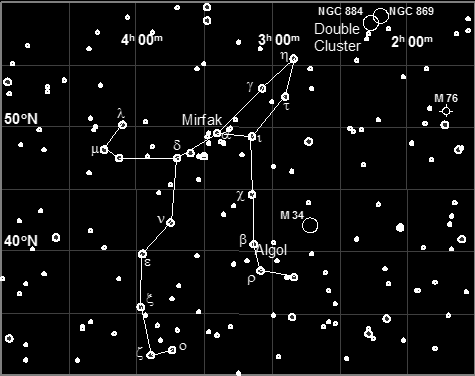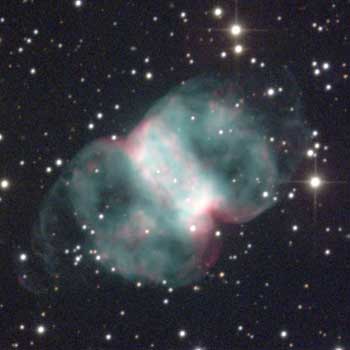Perseus
 Perseus is a very prominent constellation lying in the direction of the winter Milky Way.
Its brightest star, second magnitude Alpha or Mirfak is the leading member of a loose
cluster usually known as the Alpha Persei Association which is a splendid group for binoculars.
The most famous star in Perseus however is Beta or Algol. This is the most well known example
of a type of variable star known as the “eclipsing binaries”. Its name, meaning
“The Demon’s Head” in Arabic suggests that its variability was known about
at least as long ago as the Middle Ages. The regularity of its period was not however established
until 1782 when John Goodricke showed that it dims from its normal magnitude of 2.1 to 3.4 every
68 hours, taking about five hours to fade and about five hours to brighten again. Goodricke was
also the first to suggest the correct cause of the variability, i.e. that Algol is really a
binary system consisting of two stars orbiting each other closely, and that the dimming is
caused by the less luminous star eclipsing the brighter one.
Perseus is a very prominent constellation lying in the direction of the winter Milky Way.
Its brightest star, second magnitude Alpha or Mirfak is the leading member of a loose
cluster usually known as the Alpha Persei Association which is a splendid group for binoculars.
The most famous star in Perseus however is Beta or Algol. This is the most well known example
of a type of variable star known as the “eclipsing binaries”. Its name, meaning
“The Demon’s Head” in Arabic suggests that its variability was known about
at least as long ago as the Middle Ages. The regularity of its period was not however established
until 1782 when John Goodricke showed that it dims from its normal magnitude of 2.1 to 3.4 every
68 hours, taking about five hours to fade and about five hours to brighten again. Goodricke was
also the first to suggest the correct cause of the variability, i.e. that Algol is really a
binary system consisting of two stars orbiting each other closely, and that the dimming is
caused by the less luminous star eclipsing the brighter one.
 "Little Dumbbell" planetary nebula (M76
"Little Dumbbell" planetary nebula (M76
Perseus also contains some other very notable deep sky objects. These include two from Messier’s catalogue, the fine open cluster M34 and the planetary nebula M76. The latter is the faintest Messier object at magnitude 11, but not at all difficult to see in a small telescope. It is sometimes known as the “Little Dumbbell” because of its similarity in appearance to the more famous M27 in Vulpecula. Messier amazingly somehow neglected to include Perseus’s deep sky showpiece, the “Double Cluster” (otherwise known as NGC 869 & 884 or the “Sword Handle”) in his famous catalogue. Bright enough to be glimpsed with the naked eye, these two are a wonderful sight in binoculars and truly spectacular with low powers through a small telescope. Both are about 7,000 light years away from us and are very young clusters containing great numbers of highly luminous early main sequence stars.
POWERPOINT SLIDE SHOW (293 KB)


"Little Dumbbell" planetary nebula (M76